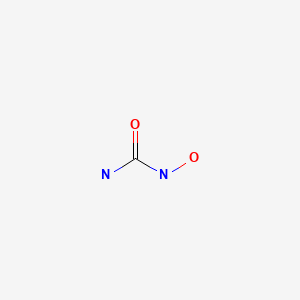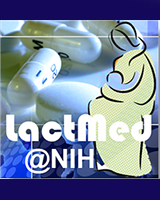Attribution Statement: LactMed is a registered trademark of the U.S. Department of Health and Human Services.
NCBI Bookshelf. A service of the National Library of Medicine, National Institutes of Health.
Drugs and Lactation Database (LactMed®) [Internet]. Bethesda (MD): National Institute of Child Health and Human Development; 2006-.
CASRN: 127-07-1

Drug Levels and Effects
Summary of Use during Lactation
Most sources consider breastfeeding to be contraindicated during maternal antineoplastic drug therapy, although the evidence for this recommendation for hydroxyurea is very weak.[1,2] Chemotherapy may adversely affect the normal microbiome and chemical makeup of breastmilk.[3]
Drug Levels
Maternal Levels. A mother was taking 500 mg of hydroxyurea orally three times a day. Milk samples taken 2 hours after the last dose of each day on 3 days averaged 6.1 mg/L (range 3.8 to 8.4 mg/L). Using these data, the infant in this case would have received less than 4% of maternal weight-adjusted dosage.[4]
Using a more modern assay, investigators measured hydroxyurea in a mother who was taking an oral dose of 1 gram once daily. Nine milk samples were taken over a 3-day period. Trough milk levels ranged from 0.51 to 1.23 mg/L and the highest level was 19.24 mg/L at 3 hours after the dose on one day. All other measurements fell between these values.[5]
Sixteen lactating mothers, 2 with sickle cell disease, were given 1 gram of hydroxyurea orally. Mothers were a median of 8.6 months (range 2.5 to 22.1 months) postpartum. Milk samples were collected before the dose and at 10 time points over the next 12 hours. A further milk sample obtained at 24 hours after the dose contained no detectable drug (<5 mg/L). Peak plasma levels averaging 12.9 mg/L (range 6.2 to 23 mg/L) occurred at a mean of 2.2 hours (range 0.9 to 3.6 hours) after the dose. Milk levels averaged about 84% of plasma levels and closely paralleled plasma levels. There was no difference between the patients and normal volunteers. The authors calculated that an average of 2.2 mg (0.41 mg/kg) was excreted into breastmilk over 24 hours, but 1.2 mg of this was in the first 3 hours. A pharmacokinetic model created using these data predicted that the daily dosage that an infant would receive would be 0.46 mg/kg daily or 3.4% of the maternal weight-adjusted dosage. By avoiding breastfeeding for 3 hours after the dose, the amount of drug transferred to the infant would be cut in half.[6]
Infant Levels. Relevant published information was not found as of the revision date.
Effects in Breastfed Infants
Relevant published information was not found as of the revision date.
Effects on Lactation and Breastmilk
Relevant published information was not found as of the revision date.
References
- 1.
- Pistilli B, Bellettini G, Giovannetti E, et al. Chemotherapy, targeted agents, antiemetics and growth-factors in human milk: How should we counsel cancer patients about breastfeeding? Cancer Treat Rev 2013;39:207-11. [PubMed: 23199900]
- 2.
- National Institutes of Health. National Heart, Lung and Blood Institute. Evidence-based management of sickle cell disease. Expert panel report. 2014. http://www
.nhlbi.nih .gov/sites/www.nhlbi .nih.gov/files/sickle-cell-disease-report.pdf - 3.
- Urbaniak C, McMillan A, Angelini M, et al. Effect of chemotherapy on the microbiota and metabolome of human milk, a case report. Microbiome 2014;2:24. [PMC free article: PMC4109383] [PubMed: 25061513]
- 4.
- Sylvester RK, Lobell M, Teresi ME, et al. Excretion of hydroxyurea into milk. Cancer 1987;60:2177-8. [PubMed: 3481556]
- 5.
- Marahatta A, Ware RE. Hydroxyurea: Analytical techniques and quantitative analysis. Blood Cells Mol Dis 2017;67:135-42. [PubMed: 28847416]
- 6.
- Ware RE, Marahatta A, Ware JL, et al. Hydroxyurea exposure in lactation: A pharmacokinetics study (HELPS). J Pediatr 2020;222:236-9. [PubMed: 32171562]
Substance Identification
Substance Name
Hydroxyurea
CAS Registry Number
127-07-1
Drug Class
Breast Feeding
Milk, Human
Antineoplastic Agents
Antisickling Agents
Enzyme Inhibitors
Nucleic Acid Synthesis Inhibitors
Disclaimer: Information presented in this database is not meant as a substitute for professional judgment. You should consult your healthcare provider for breastfeeding advice related to your particular situation. The U.S. government does not warrant or assume any liability or responsibility for the accuracy or completeness of the information on this Site.
- User and Medical Advice Disclaimer
- Drugs and Lactation Database (LactMed) - Record Format
- LactMed - Database Creation and Peer Review Process
- Fact Sheet. Drugs and Lactation Database (LactMed)
- Drugs and Lactation Database (LactMed) - Glossary
- LactMed Selected References
- Drugs and Lactation Database (LactMed) - About Dietary Supplements
- Breastfeeding Links
- PMCPubMed Central citations
- PubChem SubstanceRelated PubChem Substances
- PubMedLinks to PubMed
- Review Vincristine.[Drugs and Lactation Database (...]Review Vincristine.. Drugs and Lactation Database (LactMed®). 2006
- Review Busulfan.[Drugs and Lactation Database (...]Review Busulfan.. Drugs and Lactation Database (LactMed®). 2006
- Review Azacitidine.[Drugs and Lactation Database (...]Review Azacitidine.. Drugs and Lactation Database (LactMed®). 2006
- Review Dacarbazine.[Drugs and Lactation Database (...]Review Dacarbazine.. Drugs and Lactation Database (LactMed®). 2006
- Review Methotrexate.[Drugs and Lactation Database (...]Review Methotrexate.. Drugs and Lactation Database (LactMed®). 2006
- Hydroxyurea - Drugs and Lactation Database (LactMed®)Hydroxyurea - Drugs and Lactation Database (LactMed®)
Your browsing activity is empty.
Activity recording is turned off.
See more...
